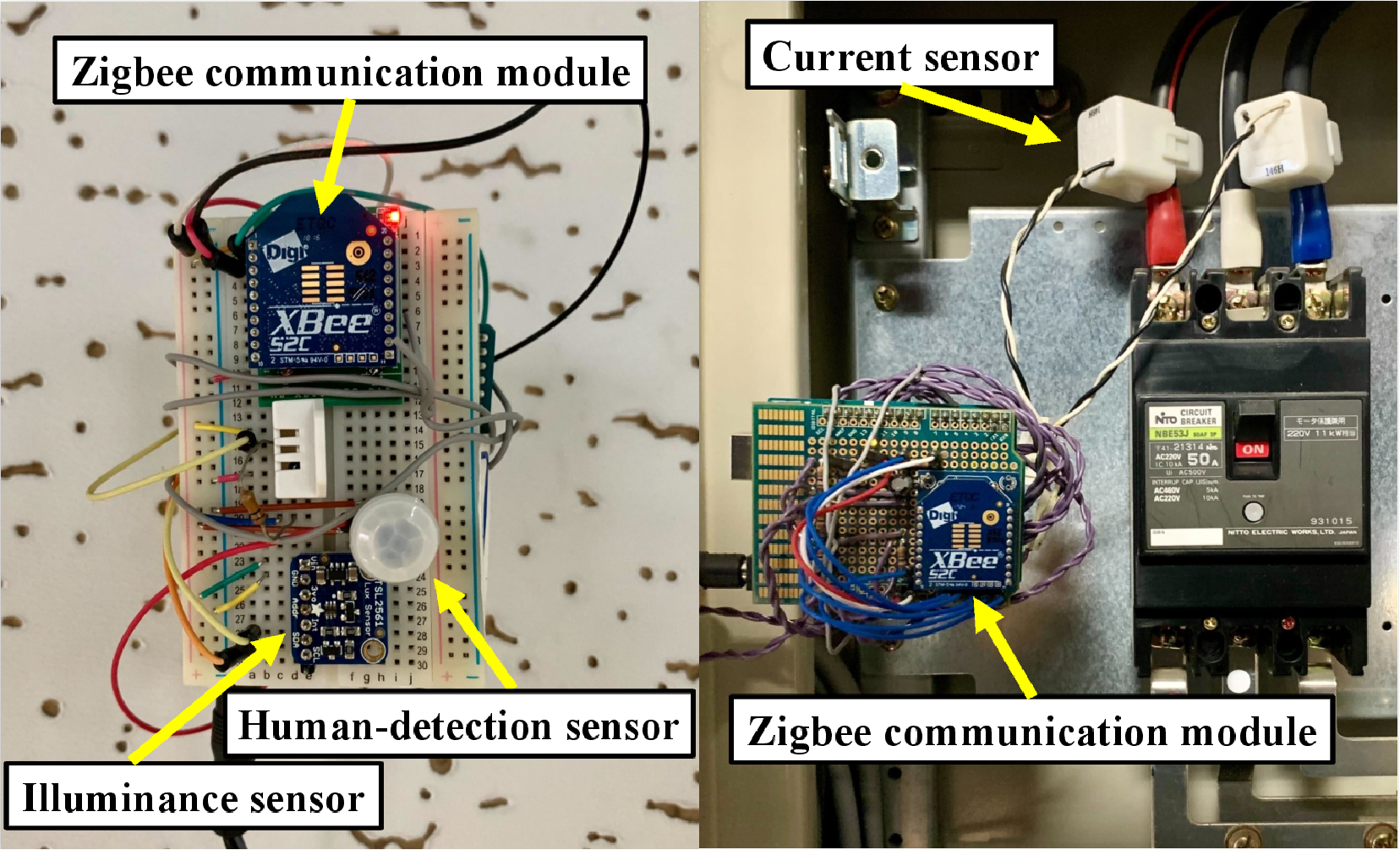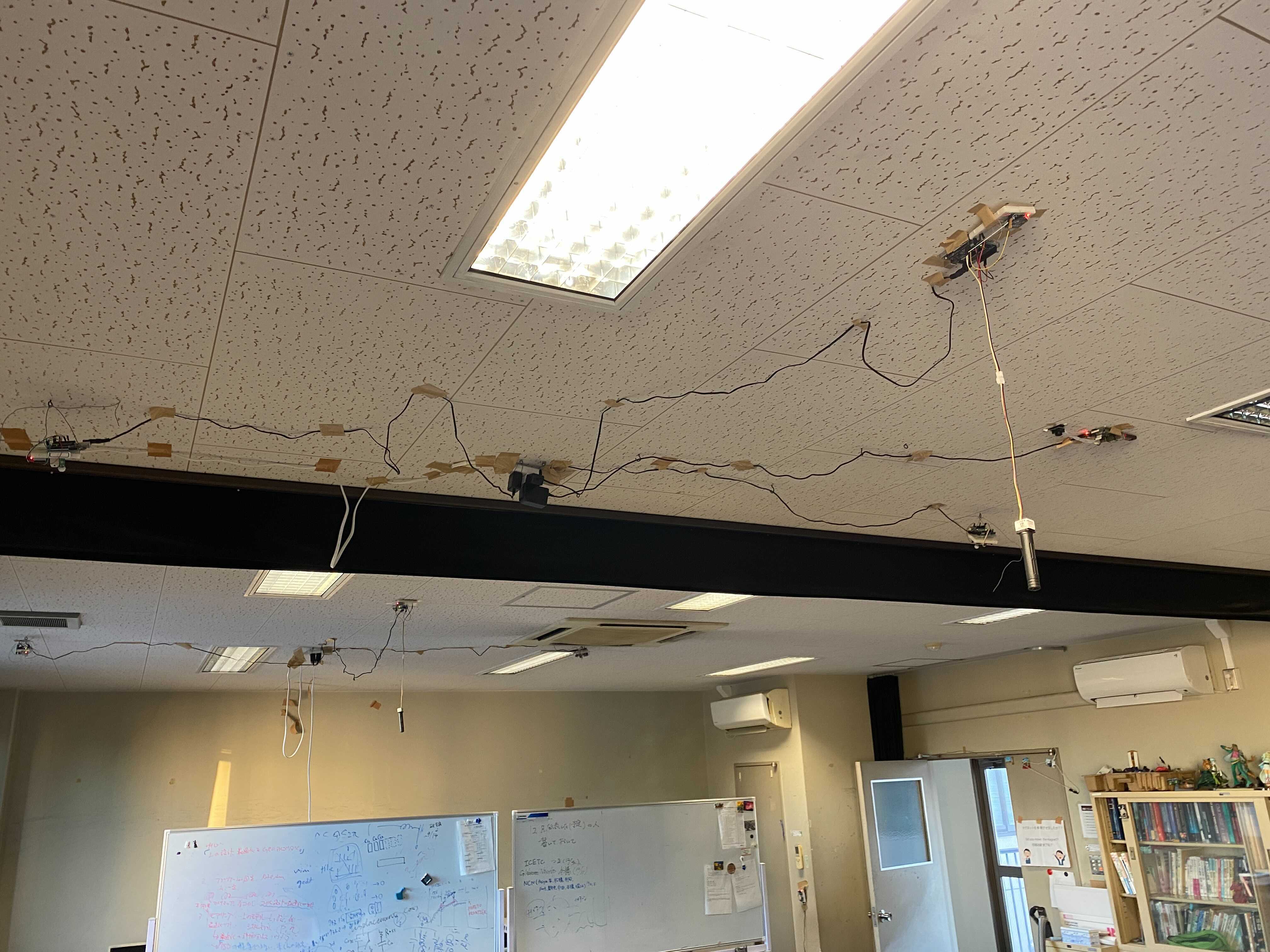The theme of our laboratory is Toward a New Information-communication Society Conscious of Energy and Environmental Problems. We conduct research on wireless communications, power supplies for communications, and neural networks.
♦ Environment and Communication
With the development of Internet of Things (IoT) technology, it has become possible to attach wireless transmitters to all kinds of sensors and automatically collect a wide variety of data. By processing the information obtained through IoT using Artificial Intelligence (AI), we can create an intelligent environmental system that supports us from real-time environmental data without human intervention. However, in order to acquire large amounts of information in real time on IoT networks, further development of communication technology is necessary, and building an information buying and selling system is also an urgent issue.
Our laboratory improves Transmission Control Protocol (TCP) and sends information using multiple communication channels (e.g., wireless, optical, etc.) to improve communication capacity and communication robustness. We are leading the research and development of Multipath TCP globally. We also aim to build an electronic payment system that allows seamless buying and selling of IoT environmental information.
♦ Power Supply Circuits and Energy Environment Issues
Currently, "energy harvesting" technologies that make effective use of all kinds of natural energy (green energy), such as solar, wind, vibration, and radio waves, are attracting attention. What is important to note here is that humankind will eventually use these energies in the form of "electricity. The circuit that modifies natural energy into a usable form of electricity is a "power circuit," and reducing power loss in this power circuit is a key technology for the effective use of natural energy in the true sense of the word.
Our laboratory is conducting research to establish various wireless power transmission systems, power supplies for EVs, and other basic technologies. We will contribute to energy and environmental issues by developing power supply circuit design software that reduces energy loss and accelerates the speed of development of high-performance power supply circuits.
♦ Intelligent IoT Networks
IoT networks acquire a wide variety of information in real time and collect it on servers. The data is then processed on the server to provide information that supports our lives. However, even if a server attempts to collect a large amount of information, there is a limit to its communication capacity (i.e., information explosion). Additionally, the power consumption of server bases is enormous, consuming enough power to require a power plant.
In our research laboratory, we aim to achieve the AI transformation of IoT networks by integrating IoT networks and Spiking Neural Networks (SNN) under the concept of "network." This integration enables intelligent information processing within IoT networks, eliminating the need for servers. As a result, significant reductions in power consumption can be achieved, contributing to environmental sustainability.
These research areas may appear to be entirely different fields, but they are actually built on a common foundation of key concepts: system development, software development, optimization.
♦ System Development
The research topics addressed in our laboratory all revolve around the design and construction of "systems." We emphasize conducting discussions without black-boxing systems and instead focus on clarifying the relationships between systems and their inputs and outputs. By embracing mathematical analysis without evading it, we have accumulated a wealth of knowledge in various aspects of analysis. Moreover, we consider "empirical evidence through experimentation" to be essential, and we have accumulated a diverse set of expertise through implementations in real systems (which are strengths and assets of our laboratory).
♦ Software Development
One of the distinctive features of our research laboratory is the ability to leverage the advantages of the department of Applied and Cognitive Informatics to develop "software" for system design. We are actively promoting the development of CAD (Computer Aided Design)" software to realize complex system development using the power of computers. Additionally, we are intensifying our research and development efforts in SDN (Software Defined Networking) for building networks with software in the implementation of communication systems. We are promoting network implementation that fully utilizes SDN technology.
♦ Optimization
As systems become larger and more complex, "optimization" to satisfy multiple desired conditions simultaneously is necessary in all fields. Most of the research themes addressed in our laboratory can be included to "optimization problems." The term "optimization" encompasses various approaches, and there are several existing methods available. The important research subject is to design an original optimization method for a new problem formulated for system design.
♦ - Background -
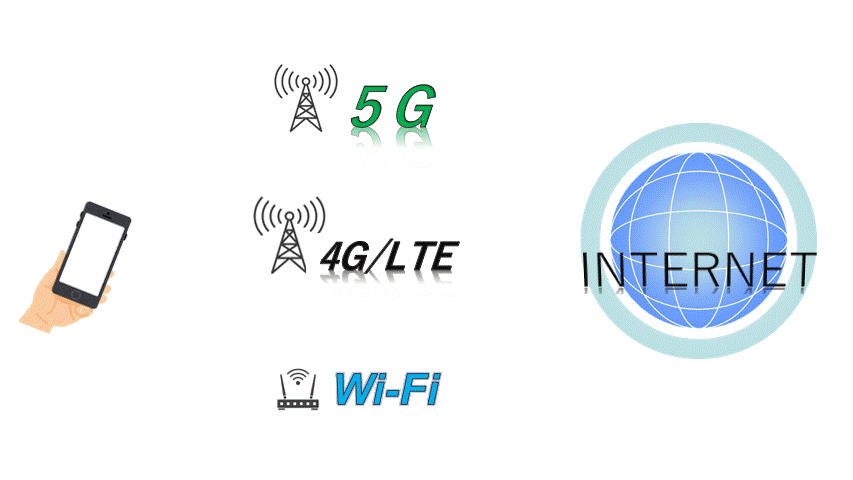 In the era of mobile wireless networks, such as 4G/LTE, 5G, 6G, and IoT, it has become common for devices to have multiple interfaces.
For example, smartphones can simultaneously use 4G/LTE and Wi-Fi, and there are various devices like IoT gateways that possess multiple wireless technologies.
Furthermore, in the communication over these networks, TCP/IP (one of the Internet Protocol Suites) has been used consistently.
According to TCP/IP specifications, data transmission from the sender to the receiver can use only one path. Therefore, devices can utilize only one interface.
In the era of mobile wireless networks, such as 4G/LTE, 5G, 6G, and IoT, it has become common for devices to have multiple interfaces.
For example, smartphones can simultaneously use 4G/LTE and Wi-Fi, and there are various devices like IoT gateways that possess multiple wireless technologies.
Furthermore, in the communication over these networks, TCP/IP (one of the Internet Protocol Suites) has been used consistently.
According to TCP/IP specifications, data transmission from the sender to the receiver can use only one path. Therefore, devices can utilize only one interface.
♦ - Multipah TCP (MPTCP) -
Multipath Transmission Control Protocol (MPTCP) is an extension of TCP that allows applications on devices to simultaneously use multiple paths. By utilizing multiple paths simultaneously, MPTCP can increase the bandwidth (frequency used for communication). Furthermore, MPTCP can also maintain communication stability even faced with path failures.
♦ - Research Topics -
MPTCP has been introduced into many platforms due to its convenience. However, as MPTCP is a relatively new technology, it has not yet achieved widespread adoption. Consequently, research combining it with other state-of-the-art technologies has not been conducted. Therefore, in our research laboratory, we are integrating MPTCP with various new technologies and conducting performance evaluations. Specific research topics are as follows:
1. MPTCP in IoT Routers
IoT routers are devices that relay and route data between IoT devices and servers. In IoT networks, IoT routers play a crucial role. When multiple IoT devices are connected to the same IoT router, network performance can deteriorate due to congestion. Therefore, to introduce high throughput and fault tolerance to address congestion issues, we have implemented MPTCP between IoT routers and servers. Furthermore, we are evaluating the performance of MPTCP in the designed network.
2. MPTCP without the need to modify user terminal settings
As previously mentioned, MPTCP is an extension of TCP, and for communication that utilizes MPTCP, both the communicating user terminals and target devices (such as servers) must be configured to support MPTCP. Based on fairness, to enable all user terminals to use MPTCP, modifications are required for many devices, including smartphones, tablets, personal computers, etc., to ensure their support for MPTCP. Therefore, in our laboratory, we are implementing the technology that allows user terminals to achieve multipath communication simply by connecting to these devices, by introducing multipath communication capabilities into network relay devices, such as switches and access points. Specifically, we are utilizing the Programming Protocol-Independent Packet Processors (P4) language, which allows direct programming of the data plane in Software-Defined Networking (SDN), to implement multipath communication capabilities in network relay devices, and we are conducting experiments and evaluations.
♦ - Background -
 The Internet environment is gradually changing to an IoT environment, and many IoT devices are now connected to the Internet.
Therefore, traditional human-to-human networks must now support machine-to-machine networks based on the IoT environment.
Micropayments is a technology that realizes this machine-to-machine network.
Micropayments refer to small payments of a few yen.
The Internet environment is gradually changing to an IoT environment, and many IoT devices are now connected to the Internet.
Therefore, traditional human-to-human networks must now support machine-to-machine networks based on the IoT environment.
Micropayments is a technology that realizes this machine-to-machine network.
Micropayments refer to small payments of a few yen.
♦ - IoT Micropayment System -
The IoT micropayment system is a system that buys and sells data obtained from IoT devices through electronic transactions. Because IoT devices handle small amounts of data at high speed, they are required to transact small amounts such as a few yen or tens of yen in real time. Therefore, an IoT micropayment system requires data management using distributed ledger technology and a micropayment system that uses a virtual currency payment method.
♦ - Research Topics -
The IoT data payment system is expected to be used in a variety of situations in the future. However, virtual currencies using traditional blockchain technology are not suitable for IoT environments due to higher computational cost. Therefore, our laboratory aims to create an IoT data payment system using a new virtual currency that is suitable for IoT environments.
1. Implementation of private blockchain on IoT devices
Blockchain is a distributed ledger technology used in many cryptocurrencies. Blockchain data management methods are expected to be used in a variety of technologies due to their high security. However, the computational work of "mining" that is essential to blockchain is too large for low-resource IoT devices. For this reason, our laboratory is building an IoT network by implementing "non-mining nodes" that do not perform mining on IoT devices. We aim to build this network and implement a virtual currency payment system using lightweight blockchain technology on IoT devices.
2. Creation of a payment system using the virtual currency "IOTA"
IOTA is a virtual currency that manages data using unique distributed ledger technology. Due to its data management method, there are no transaction fees and high-speed transactions are possible. This makes it ideal for IoT, where small-value payments are transacted in real time. Therefore, our laboratory aims to implement a micropayment system using IOTA on IoT devices. Since IOTA is the latest technology, there is very little prior research, and implementing this system will lead to the realization of a payment system that can be used for many things.
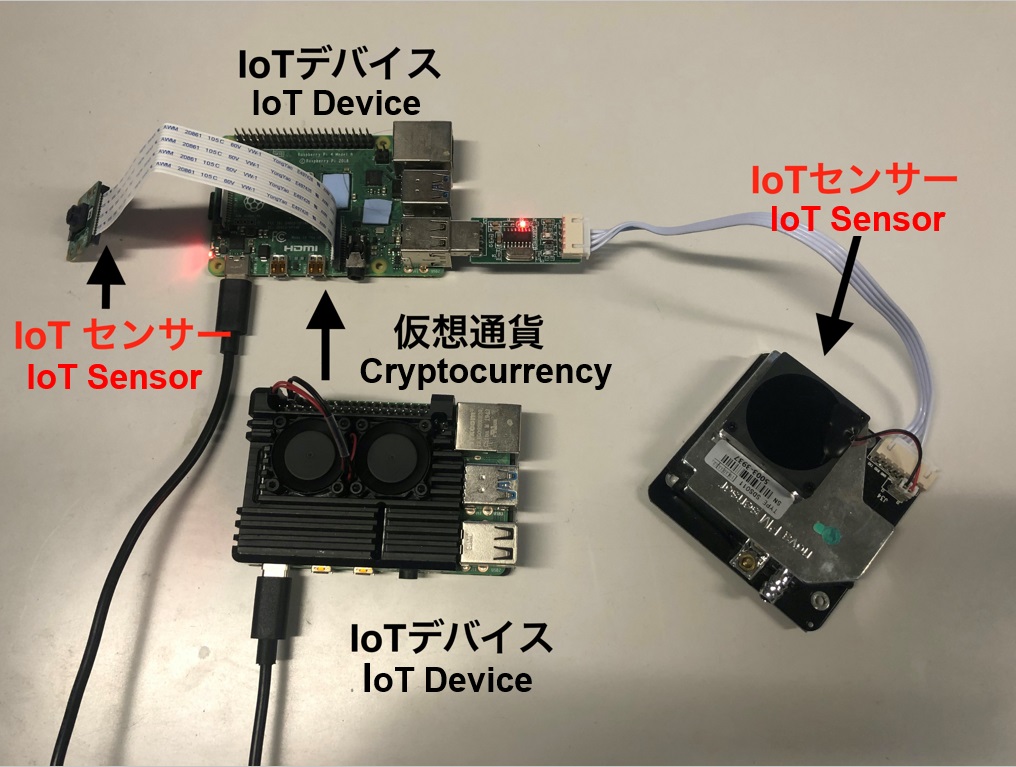
♦ - Background -
 In today's advanced information society, the miniaturization of devices is extremely importance.
The primary bottleneck for miniaturization is the power circuit (which converts voltage to the required levels for electronic components to function).
This is due to the necessity of coils (inductors) in power circuits, which inherently take up space and add weight because of their physical structure.
To achieve miniaturization of coils, increasing the operating frequency of the circuit, in other words, "high-frequency operation," is effective.
Additionally, to prolong battery life, it's crucial to operate with minimal losses (i.e., "high efficiency.")
Over the past two decades, we have been building the foundational technology for the development of small, high-frequency, and high-efficiency power circuits.
In today's advanced information society, the miniaturization of devices is extremely importance.
The primary bottleneck for miniaturization is the power circuit (which converts voltage to the required levels for electronic components to function).
This is due to the necessity of coils (inductors) in power circuits, which inherently take up space and add weight because of their physical structure.
To achieve miniaturization of coils, increasing the operating frequency of the circuit, in other words, "high-frequency operation," is effective.
Additionally, to prolong battery life, it's crucial to operate with minimal losses (i.e., "high efficiency.")
Over the past two decades, we have been building the foundational technology for the development of small, high-frequency, and high-efficiency power circuits.
In recent years, next-generation semiconductors comprising materials like gallium nitride (GaN) and silicon carbide (SiC) have emerged. These breakthroughs have made high-frequency operation a feasible reality. Within this context, the utility of our accumulated technology has been recognized, leading to various collaborative research efforts (We express our gratitude to all involved parties). In the development of real systems, a range of previously unseen challenges has come to light, necessitating the proposal of new technologies to address them.<\p>
♦ - Class E Switching -

Power circuits and amplifiers operate by controlling circuits using transistors as switches. Transistors have parasitic capacitance (capacitors) inherent in them, and the accumulation of charge in this parasitic capacitance becomes a source of energy loss. Switching loss occurs during the switching of the transistor when the charge accumulated in the parasitic capacitance of the transistor discharges suddenly. When the frequency increases, it means that the number of switchings per unit time also increases. Therefore, reducing this switching loss becomes the key to achieving high efficiency.
What could be considered the ultimate solution to switching loss is E-class switching technology. E-class switching technology involves ensuring that the voltage across the transistor is zero and its slope is also zero at the moment of switching. If E-class switching is achieved, the circuit can operate with high efficiency at high frequencies. When the voltage across the transistor is zero, it means that the charge accumulated in the parasitic capacitance is zero (Q=Cv). Therefore, even if the switch changes at that moment, there is no charge to discharge, and no loss occurs. Furthermore, making the voltage slope zero also means making the current flowing into the parasitic capacitance zero (i=Cdv/dt). Thus, setting both the voltage and its slope to zero implies that the voltage and current across the parasitic capacitance are both zero at the moment of switching. Even if the actual operating point deviates slightly from the ideal, this approach significantly reduces switching loss.
♦ - Research Topics -
Introducing E-class switching enables high-efficiency operation at high frequencies. However, it comes with a critical drawback where the load resistance fluctuates, its characteristics change drastically and its efficiency deteriorates rapidly. Addressing the issue of load variation is an urgent challenge. We are proposing and examining two approaches to provide solutions to this problem.
1. The development of characteristic visualization software and power design
We are developing software to visualize the changes in system behavior in response to load variations. This technology originated from an algorithm proposed by Prof Sekiya when he was a student and has undergone improvements over time. Using this software, we have successfully and rapidly visualized the parameter space where the system can operate efficiently in response to load variations. The output from this software provides guidance for system control, significantly improving the efficiency of system design. We aim to further advance this technology and work toward the development of software for automated design.
2. Achieving Load-Independent Operation and Unveiling New Features
We are also conducting challenging research and development aimed at eliminating problems at their root. As a fundamental technology, our laboratory focuses on "load-independent operation." Load-independent operation ensures that switching losses do not theoretically occur even when the load varies. This is an old technology proposed 30 years ago, but at that time, specific applications were lacking, and it remained obscure for a long time. However, we believe that this technology has the potential to fundamentally address various issues in practical applications. As a result, we have delved deep into "load-independent operation." We have successfully established operational modes that guarantee high efficiency even in the presence of load variations for various power circuits [4], [5]. This circuit is highly promising and has the potential to lead to various groundbreaking technologies. Currently, we are conducting investigations and evaluations from various directions [6].
[1] Hiroo Sekiya, Iwao Sasase, and Shinsaku Mori, "Computation of design values for Class E amplifiers without using waveform equations,"IEEE Transactions on Circuits and Systems Part I: Fundamental Theory and Applications, vol.49, no.7, pp.966-978, July 2002.
[2] Yuta Yamada, Tomoharu Nagashima, Yoshifumi Ibuki, Yoshiki Fukumoto, Tatsuya Ikenari, and Hiroo Sekiya, "Design of a DC-DC converter with phase-controlled class-D ZVS invertrer,"IEEE Journal on Emerging and Selected Topics in Circuits and Systems(JETCAS), pp.354-363, July 2015.
[3] Shohei Saito, Shohei Mita, Wenqi Zhu, Hiroyuki Onishi, Shingo Nagaoka,Takeshi Uematsu, Kien Nguyen, and Hiroo Sekiya, "Novel design of soft-switching resonant converter with performance visualization algorithm,"IEEE Access, vol.8, pp.59922-59933, Mar. 2020.
[4] Natsumi Obinata, Weisen Luo, Xiuqin Wei, and Hiroo Sekiya, "Analysis of load-independent class-E inverter at any duty ratio,"The 45th Annual Conference of the IEEE Industrial Electronics Society (IECON 2019), pp.1615-1620, Oct. 2019.
[5] Ayano Komanaka, Wenqi Zhu, Hiroo Sekiya, Kien Nguyen, Xiuqin Wei, "Analysis and Design of Load-Independent ZCS Parallel-Resonant Inverter at Any Duty Ratio,"IEICE Tech. Rep., vol. 119, no. 364, EE2019-53, pp. 25-30, Jan. 2020.
[6] Shuya Matsuhashi, Yoshiro Hara,Kien Nguyen, Takeshi Uematsu, Shingo Nagaoka, Taichi Mishima, and Hiroo Sekiya, "Load-independent self-tuned parallel resonant power oscillator,"The Eleventh Annual Energy Conversion Congress and Exposition (ECCE2019), Detroit, MI, USA, pp.1571-1576, Oct. 2020.
(It's also featured in Chiba University's "Distinctive Research Activities." Please have a look here for more information.)
♦ - Background -
We have all experienced the convenience that "wireless technology" has brought to our lives. For example, we can easily control air conditioners or televisions because we have remote controls. Looking at ICT-related advancements, the advent of smartphones and the transformation of our lives were made possible by wireless internet connectivity. Even when it comes to personal computers, the wireless technology for devices like keyboards and mice has significantly improved the usability of these devices. As all electrical devices become wireless, the last remaining "wire" is said to be the electrical wire that provides power.For example, in order to charge a laptop computer, it must eventually be connected to an electrical outlet by wires, and desktop computers are still cluttered with wires. In the case of desktop computers, the situation is even messier with various power cords. What is even more remarkable is the trend toward "electrification" of various things in the world today. It's likely that electric vehicles (EVs) will become commonplace in the next 10 years, and there are considerations for fully electrifying airplanes as well. In such a scenario, the importance of "how power is delivered" is expected to increase more than ever before.

♦ - Wireless Power Transfer -
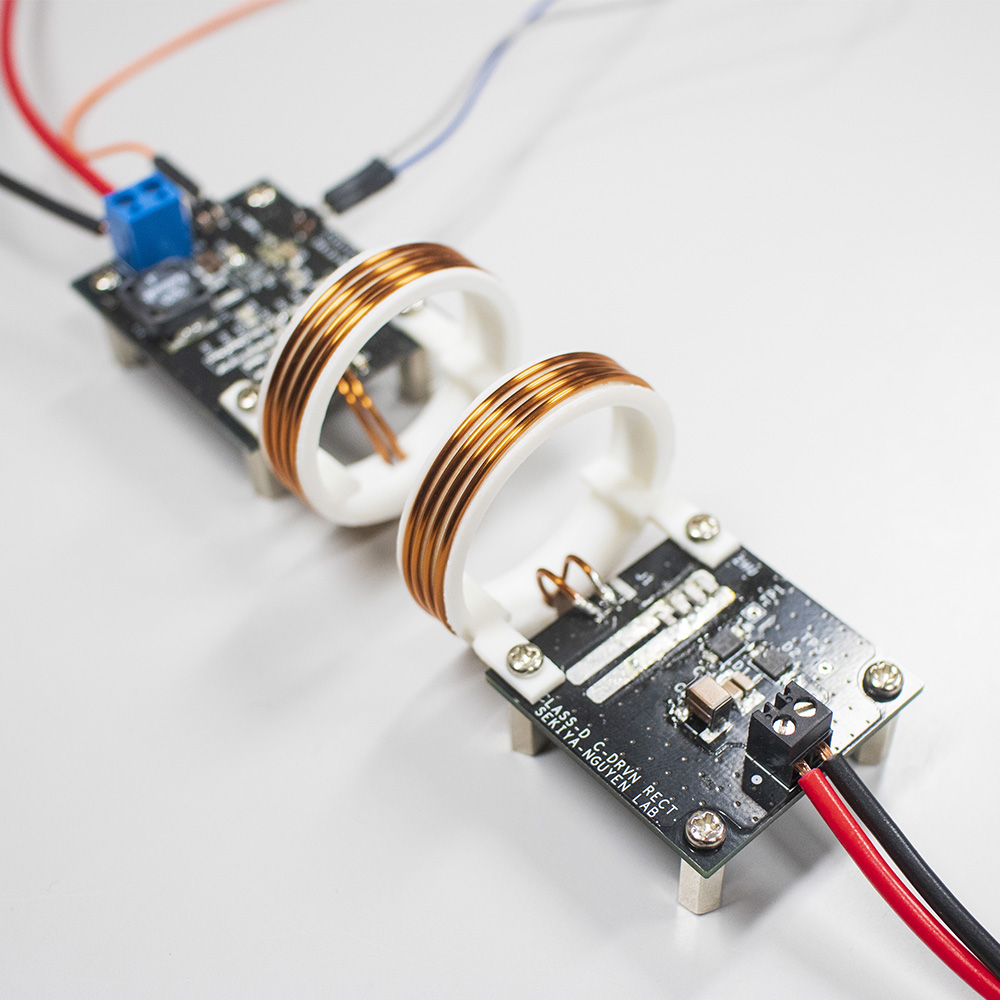
Wireless power transmission (WPT) systems are aimed at making power transmission wireless. The iPhone's "just-placed charging" and the charging of electronic toothbrushes are familiar examples of wireless power transmission. In the future, there will be a demand for the development of specialized WPT systems targeting various appliances like televisions, vacuum cleaners, and electric vehicles (EVs).
When it comes to transmitting power wirelessly, there are several methods, including using a magnetic field (coils), an electric field (capacitors), or electromagnetic waves.
In our lab, we primarily focus on the method that uses a magnetic field.
When considering the miniaturization of wireless power transmission systems, the use of coils is essential, which leads to a requirement for "higher frequencies."
At this point, we can draw upon our expertise in "high-frequency power" technology.
In fact, there are many commonalities, and by leveraging this knowledge, we believe we can propose new technologies.
♦- Research Topics -
In our laboratory, we are advancing the research and development of high-frequency wireless power transmission systems. Leveraging the expertise we have accumulated over time, especially in high-frequency power technology, and by making effective use of E-class switching, we aim to establish the foundational technology for transmitting power with minimal losses in the high-frequency range. Specific research topics include the following:
1. Charging for IoT Devices
For IoT devices, power is typically supplied by batteries, and in some cases, it's assumed that once the batteries are depleted, the devices may be discarded rather than having their batteries replaced or recharged. This approach is often taken due to cost considerations associated with battery replacement or recharging. IoT devices are designed to be deployed widely, and devices with batteries containing chemical substances may pose environmental risks if left unattended. The development of Wireless Power Transfer (WPT) systems could provide a fundamental solution to this issue. WPT systems have the potential to allow IoT devices to be powered wirelessly, eliminating the need for batteries, and thus addressing the environmental concerns associated with battery disposal.
Our laboratory is working on implementing a Wireless Power Transfer (WPT) system using drones. While there has been significant research into charging drones, there is relatively limited exploration of leveraging the mobility of drones for wireless power delivery. If this can be achieved, it has the potential to lead to the realization of a power delivery system that is not constrained by spatial limitations. This innovative approach can open new possibilities for a wide range of applications, making it possible to provide power to devices or areas that are difficult to reach or where traditional power infrastructure is not available.
2. Realization of Multi-Hop Multi-Output System
For example, let's place a large coil on a desk. In this scenario, You can imagine how convenient it would be to be able to charge the battery stably anywhere on the desk. Embedding coils in the walls of a house could eliminate the need for power cables for wall-mounted TVs or air conditioners, providing greater flexibility in home layout. Furthermore, if power can be transmitted through multiple coils, it can extend the distance over which power can be delivered. This could enable applications like providing power to industrial robots or robotic arms. The problem here is that the strength of the magnetic field inside the coils varies depending on the location (weaker at the end of the life), resulting in a variation in the ability to transmit power from one location to another.
Therefore, in our laboratory, we are developing mathematical models for these multi-hop, multi-output WPT systems. Our goal is to use the insights obtained from these models to construct a system that can provide stable power delivery at any location. To achieve this, we are exploring the applicability of concepts like "load-independent operation" introduced in the high-frequency power source theme. This will help us address the challenges posed by varying magnetic field strengths and achieve a stable power transfer system, regardless of where devices are placed.

♦ - Background -
IoT (Internet of Things) and AI (Artificial Intelligence) are groundbreaking technologies that significantly augment human capabilities (IoT corresponds to the nerves, AI to the brain).
These technologies are central to realizing "Society 5.0," as emphasized in the "Future Investment Strategy 2018."
They enable the delivery of personalized products and services, moving away from the traditional model of mass production and mass consumption.
 By leveraging IoT and AI, we can tackle various societal challenges and create substantial added value.
The integration of IoT and AI technologies has the potential to revolutionize our approach to commerce, industry, and daily life.
The concept of "Society 5.0" envisions a society where these technologies empower us to address complex issues and drive innovation in unprecedented ways.
By leveraging IoT and AI, we can tackle various societal challenges and create substantial added value.
The integration of IoT and AI technologies has the potential to revolutionize our approach to commerce, industry, and daily life.
The concept of "Society 5.0" envisions a society where these technologies empower us to address complex issues and drive innovation in unprecedented ways.
IoT is a technology that enables the seamless and cost-effective collection of vast amounts of data through the networked connection of various sensors using wireless communication. While it simplifies and automates the continuous gathering of data, there are challenges to consider. The exponential growth of data generated by IoT devices has resulted in significant energy consumption. To process this data, data centers often require energy equivalent to that produced by entire power plants. This energy consumption stands in contrast to the increasing emphasis on environmental consciousness and energy efficiency. Furthermore, IoT faces limitations in terms of wireless communication capacity. There is a growing concern about reaching the limits of the data that can be transmitted to data servers. This situation is referred to as "data explosion" or "data burst." These challenges necessitate innovative approaches to address the energy efficiency and data handling capacity of IoT systems, which align with the broader goals of sustainability and effective data management.

♦ Wireless Brain-Inspired Computing(WiBIC)
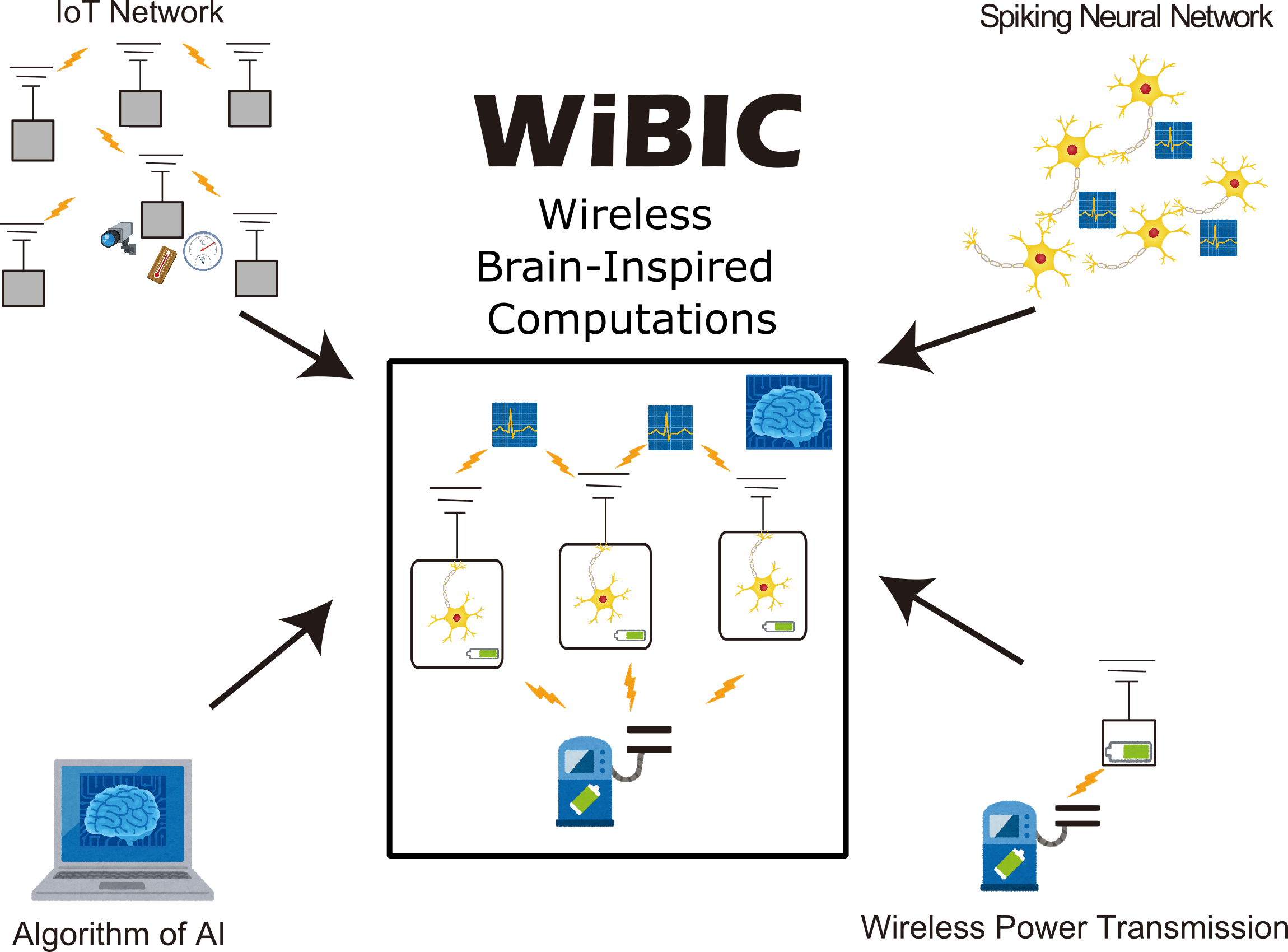 Biological brains are capable of ultra-high-level information processing with extremely low energy consumption by transmitting and receiving pulse signals.
This biological concept has led to the emergence of the Spiking Neural Network (SNN) as a promising next-generation AI paradigm.
Here, a novel concept called "Wireless SNN" integrates the information collection capabilities of the IoT network with the information transmission among neurons using pulse sequences in SNNs.
This integration forms the foundation for a next-generation information processing platform called "WiBIC".
WiBIC is designed to equip IoT devices with neuron-like functionality, enabling them to convert collected environmental information into pulse signals and perform intelligent information processing on-site.
It boasts several key features, including ultra-low power consumption, high mobility through complete wireless operation (including power supply), and the ability for the wireless network itself to acquire various functionalities through learning.
As a result, WiBIC can create diverse ambient Intelligence systems at low cost, without being constrained by installation locations.
Biological brains are capable of ultra-high-level information processing with extremely low energy consumption by transmitting and receiving pulse signals.
This biological concept has led to the emergence of the Spiking Neural Network (SNN) as a promising next-generation AI paradigm.
Here, a novel concept called "Wireless SNN" integrates the information collection capabilities of the IoT network with the information transmission among neurons using pulse sequences in SNNs.
This integration forms the foundation for a next-generation information processing platform called "WiBIC".
WiBIC is designed to equip IoT devices with neuron-like functionality, enabling them to convert collected environmental information into pulse signals and perform intelligent information processing on-site.
It boasts several key features, including ultra-low power consumption, high mobility through complete wireless operation (including power supply), and the ability for the wireless network itself to acquire various functionalities through learning.
As a result, WiBIC can create diverse ambient Intelligence systems at low cost, without being constrained by installation locations.
♦ - Research Topics -
As outlined earlier, we are actively engaged in research and development to bring the WiBIC concept to life. In the initial phase of this project, we implemented Spiking Neurons on Field Programmable Gate Arrays (FPGAs), allowing for circuit reconfiguration. We then established communication between the FPGA neurons by transmitting spike signals using IoT wireless devices. During this process, we equipped both the FPGA neurons and IoT devices with sensors. This integration enabled us to process data collected by the sensors on-site, a pivotal step toward realizing the WiBIC vision.
1. Realization of Wireless Spiking Neural Network
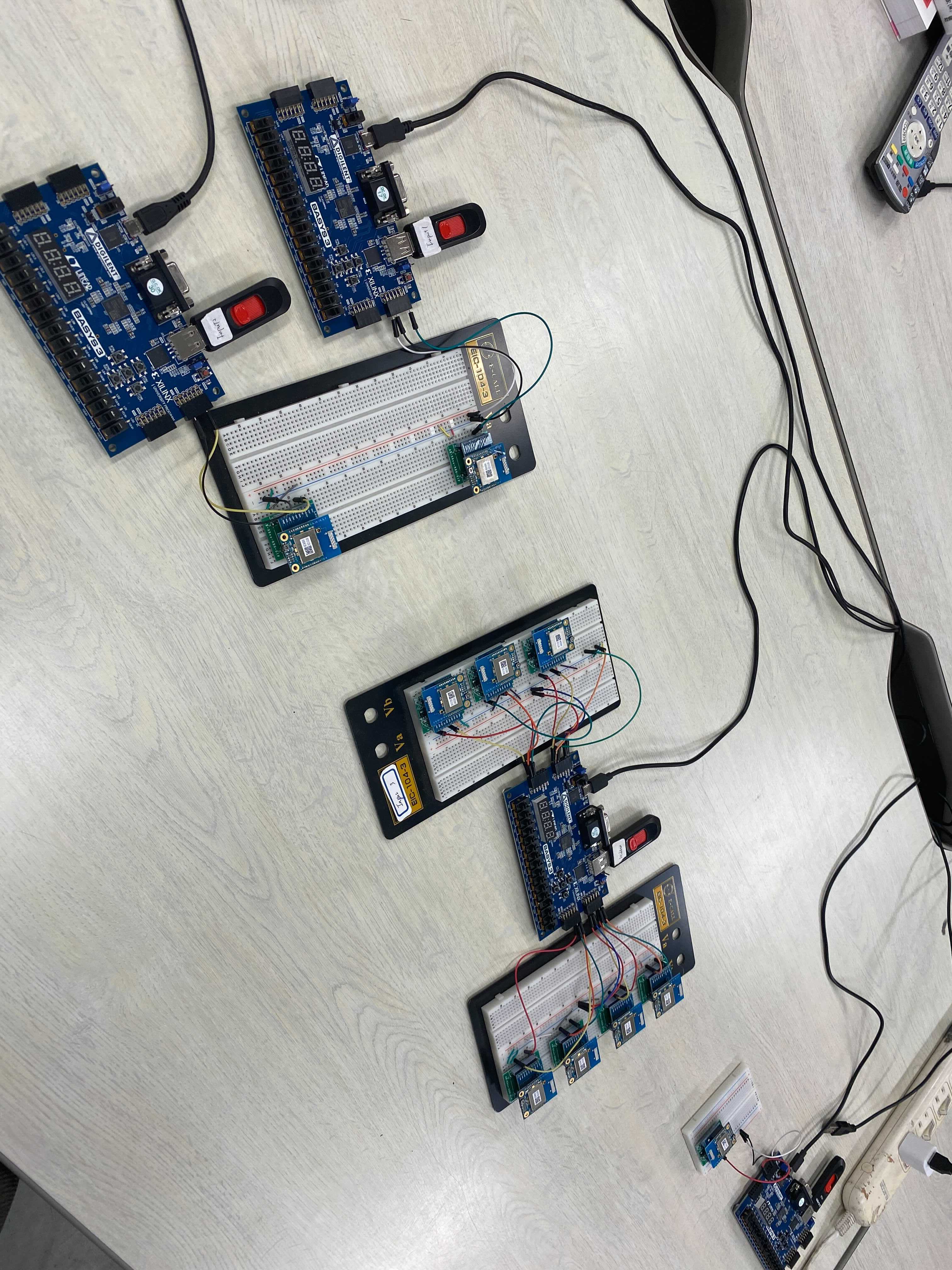 The advantage of WiBIC is the acquisition of convenience through wireless capabilities.
To achieve this, the complete wireless operation of the system is essential.
Therefore, the development of a wireless communication method for connecting FPGA neurons becomes a crucial research task.
Furthermore, we are progressing in the development of a wireless power supply system for each device.
Consequently, research on WiBIC involves integrated research challenges that require knowledge in both communication and power supply domains.
The advantage of WiBIC is the acquisition of convenience through wireless capabilities.
To achieve this, the complete wireless operation of the system is essential.
Therefore, the development of a wireless communication method for connecting FPGA neurons becomes a crucial research task.
Furthermore, we are progressing in the development of a wireless power supply system for each device.
Consequently, research on WiBIC involves integrated research challenges that require knowledge in both communication and power supply domains.
2. Development of an In-Room Occupancy Estimation System
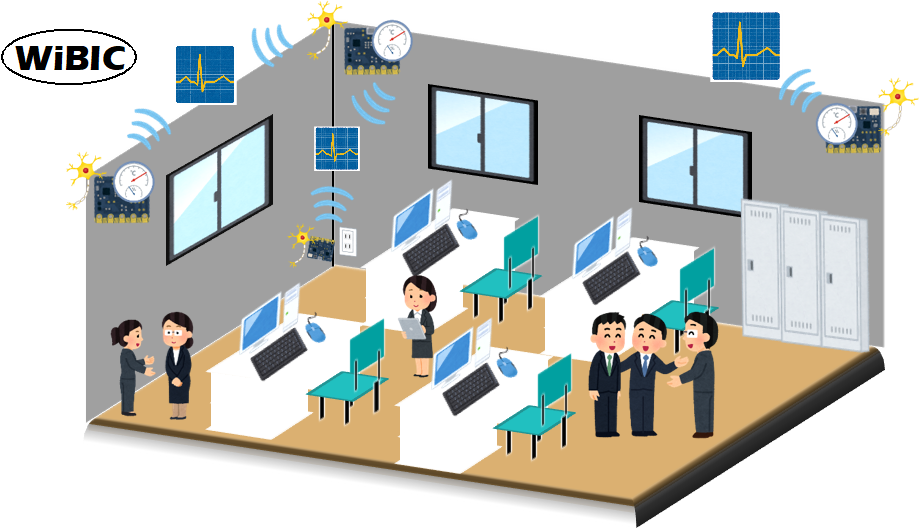
The indoor occupancy estimation system is expected to have various ripple effects, such as Energy Management System (EMS) through the management of air conditioning and lighting in buildings, crime prevention by detecting intruders, and detection of the density of people, which has recently attracted attention in COVID-19 pandemic. However, the current situation presents significant challenges in terms of ease of installation and cost. Therefore, we aim to develop an occupancy estimation system based on environmental information using WiBIC with reservoir computing.
